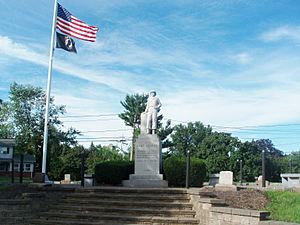Camp Shanks facts for kids
Camp Shanks was a very important Army base located in Orangeburg, New York. It was named after Major General David C. Shanks. This camp was the biggest place in the U.S. where soldiers got ready to travel overseas during World War II. It was located near the Hudson River and the Erie Railroad.
Contents
What Was Camp Shanks?
Camp Shanks was like a giant waiting room for soldiers heading to war. It was often called “Last Stop USA” because it was the last place many soldiers stayed before sailing across the ocean. The camp was huge, covering about 2,040 acres (8.3 km2) of land.
A Busy Hub for Soldiers
During World War II, Camp Shanks helped prepare about 1.3 million soldiers for their journeys. This included a large number of the troops who took part in the famous D-Day invasion. After the war ended, the camp also held German and Italian prisoners of war for a short time.
From Camp to Village
After World War II, the army barracks at Camp Shanks were changed into homes. These homes were for veterans and their families who were going to college in New York City. This new community was called Shanks Village. It closed in 1954, and the land became civilian property again. Today, part of the Palisades Interstate Parkway runs through where Camp Shanks used to be.
Visiting the Museum
If you want to learn more, the Camp Shanks Museum opened in June 1994. It's located near the original site, at the crossing of Route 303 and Route 340.
Building the Camp
The construction of Camp Shanks happened very quickly. On September 25, 1942, people living in Orangeburg learned that their homes and farms were needed for the new military camp. About 130 families had to move from their homes. The United States needed to build more military bases around New York City to send troops and supplies to Europe.
A Fast Project
Camp Shanks was built in a hurry between September 1942 and May 1943. It cost a lot of money, over $44 million! The camp officially opened on January 4, 1943. The soldiers lived in simple barracks that were 20 feet wide and 100 feet long. These buildings had two rows of bunk beds and three small stoves for heat.
Women in the Army
More than 400 women from the Women's Army Corps (WAC) also worked at Camp Shanks. They had many important jobs, like clerks, mechanics, and warehouse staff.
Preparing for Overseas Travel
Camp Shanks was one of three main places on the East Coast where soldiers got ready for war. The other two were Fort Hamilton in Brooklyn and Camp Kilmer in New Brunswick, NJ. Together, these camps formed the largest staging area in the world.
Getting Ready to Go
A main job of Camp Shanks was to make sure every soldier had all their equipment before going to Europe. Soldiers carried their essential items in backpacks or large bags. At first, there weren't many supply depots in England, so soldiers had to bring everything with them.
The "Alert" Call
When soldiers were told they were on "Alert" status, they knew they would be leaving within 12 hours. They would remove their division patches and have a letter and number written on their helmets. This helped them know where to march and which train car to get on. It was a short train ride to the New Jersey docks. From there, a boat would take them to a large troopship waiting to cross the ocean. Some troops also marched about four miles to the Piermont Pier to board their ships.
Prisoners of War at Camp Shanks
From April 1945 to January 1946, Camp Shanks also held about 1,200 Italian and 800 German prisoners of war. After the war ended, around 290,000 prisoners passed through Camp Shanks. They were processed there before being sent back to their home countries. The last German prisoner left on July 22, 1946, and the camp closed that same month.
Images for kids



